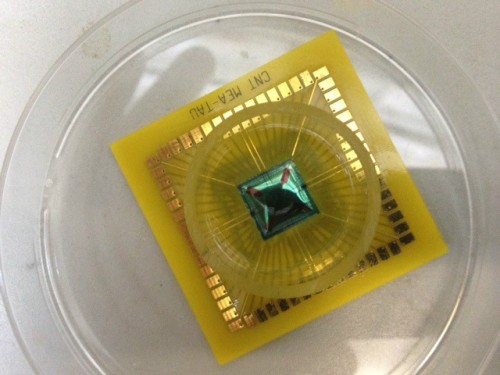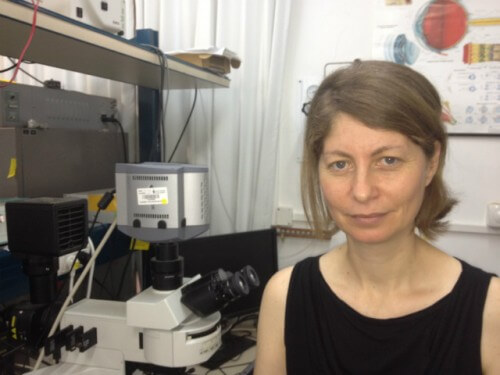Scientists at Tel Aviv University are developing an innovative implant that can improve the sight of blind people

Almost 40 million people in the world are blind. In Israel their number is estimated at 30,000. According to data from the World Health Organization, more than 60% of the blind lost their sight at a relatively old age, due to age-related diseases, chief among them cataracts and degeneration of the retina. Development of the Center for Nanotechnology at Tel Aviv University, could - perhaps - help the blind who have lost their sight due to retinal degeneration in the foreseeable future. The research team there is working on developing a chip that will be implanted in the eye and replace the activity of the damaged retinal cells: it will receive light, translate it into electrical signals and transmit them to the optic nerve.
Many research groups in the world are trying to develop similar solutions. The advantage of the Tel Aviv development is the use of nanotechnology to produce a structure based on tiny carbon tubes. "The basis of the technology is nanoscale materials, the connection between which and the biological system enables neural activation of those cells that are supposed to transmit the information to the brain," explains Prof. Yael Hanin, who heads the Center for Nanotechnology. "One of the biggest challenges facing those involved in the field is how to operate in the most efficient way the interface between the electronic component that is supposed to give the electrical signal, and the biological system."
future technology
The chip intended for implantation will consist of the tiny tubes, which are supposed to conduct the signal to the nervous system, and to which will be connected a light-sensitive material that is supposed to do the processing from light waves to electrical signals. The entire device, which is a few millimeters in size, is wrapped in a soft material that should prevent irritation of the tissue as much as possible, to prevent the eye cells from rejecting the implant. The development of the implant took several years, and now the researchers are working, among other things, on developing a method for implanting the device in the eye of a mammal, alongside research and perfecting the activity of light processing and its translation into neural signals. Some of the work is done in collaboration with other research groups in Israel and abroad.
Among other things, the researchers are trying to develop an independent implant, which will not depend on an external energy source. "There are several projects in the world that have been worked on in recent years in the field," says Prof. Hanin. "The technology we are developing is future technology, which we hope will push forward the existing technology today. I hope that in five years the things we are working on today can be considered as an option to enter these technologies."
Quality of Life

It is important to emphasize, even if everything succeeds as planned, it is still not an implant that will restore the blind to their full sight. The human eye operates in a much more complex mechanism than simple detection of light intensity. It's like a prosthetic arm or leg, the researchers say - such a prosthesis is not close to the performance of natural limbs, but it greatly improves the transplanted person's quality of life. In a similar way, they hope that the retinal implant will allow transplant recipients to navigate their surroundings, be independent and enjoy a significant improvement in the quality of life, first for those suffering from degenerative diseases of the retina, in whom the optic nerve should still be active, and later perhaps also for those suffering from blindness for other reasons.

5 תגובות
Another interesting section on the subject, under the title "Bionic Eye" here:
http://sciam.co.il/archives/5591
In the meantime, until this technology is developed, is it not possible to perform a retinal transplant from a donor?
The stimulating electrode must be separated from the CCD optical sensor, which does not have to be in the eye
Oops
Zerner's technology - use of photovoltaic cells under the retina (on, in the case of nano-retina) that receive the light that falls on it and convert it into electrical signals with the help of an external power source.
interesting!!!! (Not sarcastically! This is really a description of the future generation)
Too bad it's a little lacking in detail. Does it mean that every carbon tube will function as an electrode? Does the chip stimulate each tube separately? How do you connect the tubes to the electronics (or in the case of nanoretina to the photovoltaic cells)?
As someone who only knows a little bit about carbon tubes, this looks promising - it makes it possible to stimulate single or even just one neuron. But how do you decide, and even more so, how do you choose a specific one and "push" the appropriate stimulus to it?
As someone who knows a little about the subfield of neurostimulators, the main problem is to protect the body from the electronics, and vice versa, while you connect to dozens (now), hundreds (near future), thousands (distant future) of electrodes.
The electrodes are connected (physically) on one side to the electronics and on the other side sit in the body tissue. This connection should be hermetic, biocompatible and last for years. This is currently one of the main problems, if not the main one.
Just a comment. Because they were mentioned in the article - the concept of nano-retina is, in my opinion and from the very little I know about them, the most suitable concept in the existing technology. Like Flanker (Yossi Mendel - for national pride which is very important these days) they take Zerner's technology but provide power without wires.
Successfully!!
post Scriptum. In the picture, is it the chip with the carbon tubes or something else?